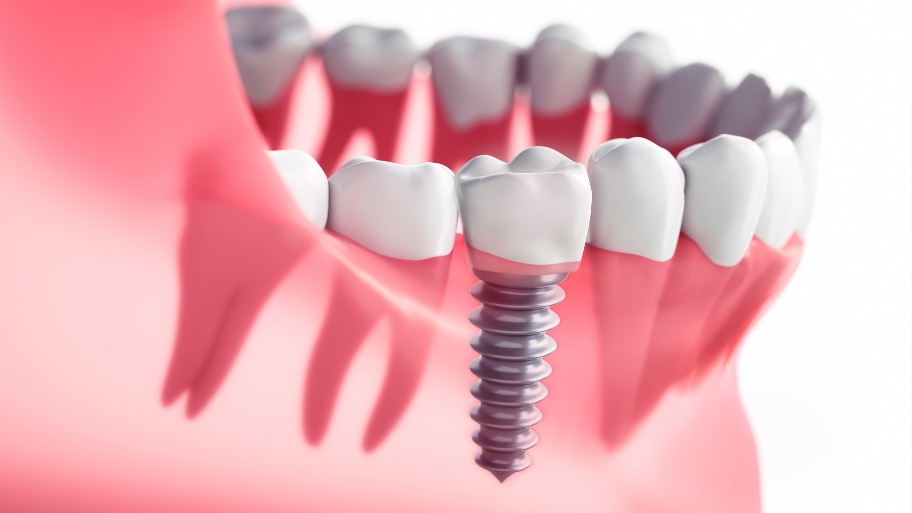When you lose a tooth, you’re not just missing the visible crown—you’re also missing the root that once anchored it in your jaw.
The dental implant procedure replaces that root with a small titanium post, which is carefully placed into the jawbone where the tooth used to be.

Over time, your body naturally heals around the implant through a process called osseointegration. This means the implant actually fuses with your jawbone, becoming a stable, permanent foundation—just like a natural root.
The result? A strong, secure replacement that not only holds a crown in place but also helps prevent bone loss, maintain your facial structure, and restore real chewing strength. It’s the closest thing to getting your natural tooth back.
The dental implant procedure is completed in stages over several months. Each stage plays a key role in making sure your new tooth is strong, stable, and built to last.
Here’s a quick breakdown of what to expect:
1️⃣ Initial evaluation – Imaging, dental history, and jawbone assessment
2️⃣ Treatment planning – Custom roadmap based on your oral health
3️⃣ Implant placement – Titanium post is surgically positioned into the jaw
4️⃣ Healing period – Your bone fuses with the implant (osseointegration)
5️⃣ Abutment placement – Connector piece added after healing
6️⃣ Final restoration – A lifelike crown is attached to complete your smile
Each step builds on the last to restore not just the look—but the full function—of your missing tooth.
Now that you’ve seen the big picture, let’s break down what each stage of the dental implant procedure actually involves—and what it means for you as a patient.
This part of the journey is all about precision, healing, and rebuilding strength from the root up.
Your implant journey begins with a detailed exam and planning session. At this visit, your dentist will:
✅ Take 3D scans and X-rays of your mouth
✅ Review your dental and medical history
✅ Examine your jawbone to see if it’s strong enough to support an implant
If the bone has weakened due to tooth loss or aging, your dentist may recommend a bone graft. This procedure adds or encourages new bone growth, creating a stable foundation for the implant.
While not everyone needs one, it’s a key part of making sure the implant will hold securely for years to come.
This step ensures that everything is set up for long-term success before any surgery begins.
Once your treatment plan is ready, the implant placement takes place. This involves inserting a small titanium post directly into your jawbone. It sounds intense—but most patients say it feels more like pressure than pain.
Here’s what to expect:
✅ The area will be fully numbed with local anesthesia
✅ The procedure usually takes under an hour
✅ You’ll receive aftercare instructions to support healing
You might notice mild swelling or tenderness afterward, but that’s completely normal and manageable with simple pain relief. Most people return to their daily routines within a day or two.
After the implant is placed, the healing begins—and this is where the real strength forms.
Your jawbone gradually grows around the titanium post in a process called osseointegration, locking it in place as if it were a natural root. This phase typically takes a few months, but you won’t feel it happening.
During this time:
✅ You’ll likely use a temporary tooth for comfort and appearance
✅ Your dentist will monitor your healing progress
✅ You’ll be encouraged to maintain good oral hygiene and avoid hard foods
This stage is critical because it’s what gives the implant its root-level stability and allows it to last for decades, not just years.
Once your jawbone has fully bonded with the implant, you’re ready for the finishing touches.
Your dentist will secure a small connector piece called an abutment, which holds the crown securely in place. Then, your custom-made crown—designed to match the size, shape, and color of your natural teeth—is placed on top.
The final result:
✅ Looks genuine and blends in with your smile
✅ Feels secure when you chew, talk, or laugh
✅ Functions like a real tooth from root to crown
This is the point where your smile is fully restored—and it feels like your tooth was never missing at all.
Once your dental implant is placed, recovery begins. And while the idea of healing from oral surgery might sound intimidating, the truth is most patients are surprised by how manageable the process really is.
In the first few days after the procedure, it’s completely normal to experience:
🦷 Mild swelling around the gums and jaw
🦷 Tenderness near the implant site
🦷 Limited chewing ability, especially on that side of your mouth
These symptoms usually peak within the first 48 hours and taper off quickly with proper care.
Stick to soft foods for the first few days—think smoothies, yogurt, mashed potatoes, or scrambled eggs. Avoid hot drinks, spicy foods, or anything crunchy that might irritate the area.
When it comes to cleaning:
🦷 Gently cleanse with warm salt water (as recommended by your dentist)
🦷 Don’t brushing directly over the implant site for the first few days
🦷 Resume regular brushing and flossing elsewhere as normal
Following your dentist’s instructions here goes a long way in preventing complications.
🦷 Most people return to daily activities within 24–48 hours
🦷 Discomfort typically fades within a week
🦷 Full healing (when the bone fully fuses with the implant) takes 3–6 months
You won’t feel the osseointegration process, but you’ll know it’s working as your mouth feels stronger and more stable with time.
If you ever feel unsure during recovery—whether it’s pain, swelling, or just a question—don’t hesitate to reach out to your dentist. You’re not alone in the healing process.
Once your dental implant is completely healed and restored, it’s not just a short-term fix—it’s built to go the distance.
With proper care, most dental implants last 10 to 20 years—and many last a lifetime.
This long-term success is one of the reasons more patients are discovering the truth about dental implants as a dependable alternative to bridges and dentures.
They don’t rely on other teeth for support like bridges do
They stimulate your jawbone, preventing the bone loss that can cause dentures to loosen over time
They’re anchored directly into your bone, so they won’t shift, slip, or wear down nearby teeth
The result? A solution that doesn’t just restore your smile today—but helps protect it for the future.
Brush and floss, clean it like you would with your natural teeth
Don’t using your teeth to open packages or bite hard objects
Schedule regular, routine cleanings and checkups with your dentist
Let your dentist know if you grind your teeth—they may recommend a night guard
Think of your implant as an investment in your smile. With just a little upkeep, it can pay off for decades to come.
If you’ve been living with a missing tooth—or several—you know it affects more than just your smile. It changes how you eat, how you speak, and how you feel about yourself.
At Dimples Family Dentistry in Norwalk, IA, we don’t just replace teeth—we help restore confidence, comfort, and quality of life. Our dental implant procedures are designed to go deeper than the surface, offering root-level strength and stability that truly lasts.
Whether you’re just starting to research your options or you’re ready to move forward, our team is here to help you make an informed, pressure-free decision. We’ll walk you through every step, answer your questions, and craft a plan that fits your needs and goals.
👉 Schedule your consultation today and let us help you take the first step toward a stronger, more confident smile—starting at the root.

Dr. Roos was raised in West Des Moines, IA. He attended Valley High School and went to college at Luther College in Decorah, IA. He graduated from the University of Iowa College of Dentistry in 2004. He has attended numerous post-graduate courses in endodontics and orthodontics. He is a member of the American Dental Association, the Iowa Dental Association, and the American Orthodontic Society.
Dr. Roos is married to his wife Sara and they have 6 children. He enjoys spending time with his wife and children, gardening, landscaping, and farming with his cousin on their family farms in Avoca, IA.
I've been seeing Dr. Ethan Roos at Dimples Dentistry for over 5 years and have always been happy with the care I've received here. The staff has always been very welcoming, as if you are part of the family. I highly recommend!!
Called Dimples and wish I called them first. Their receptionist was SO kind and SO helpful. Even offered to call to have my records sent to them in hopes to save me some money from doing x rays again. She was nothing but sweet! Got me scheduled within 2 days. Went above and beyond and was kind when I arrived.
Dr. Roos and his staff are incredibly professional, kind, and knowledgeable. Their pricing is also extremely reasonable, even for those without insurance. We had an excellent experience with a dental emergency exam; they also had availability to fit us in for a routine exam and cleaning after the emergency exam.
The contents of this website including text, graphics, images, and other materials are provided for informational purposes only and are not intended to be a substitute for professional health advice, diagnosis, or treatment.
Copyright 2019-2023 Dimples Family Dentistry, P.C. | Website Design By: RB Web Development